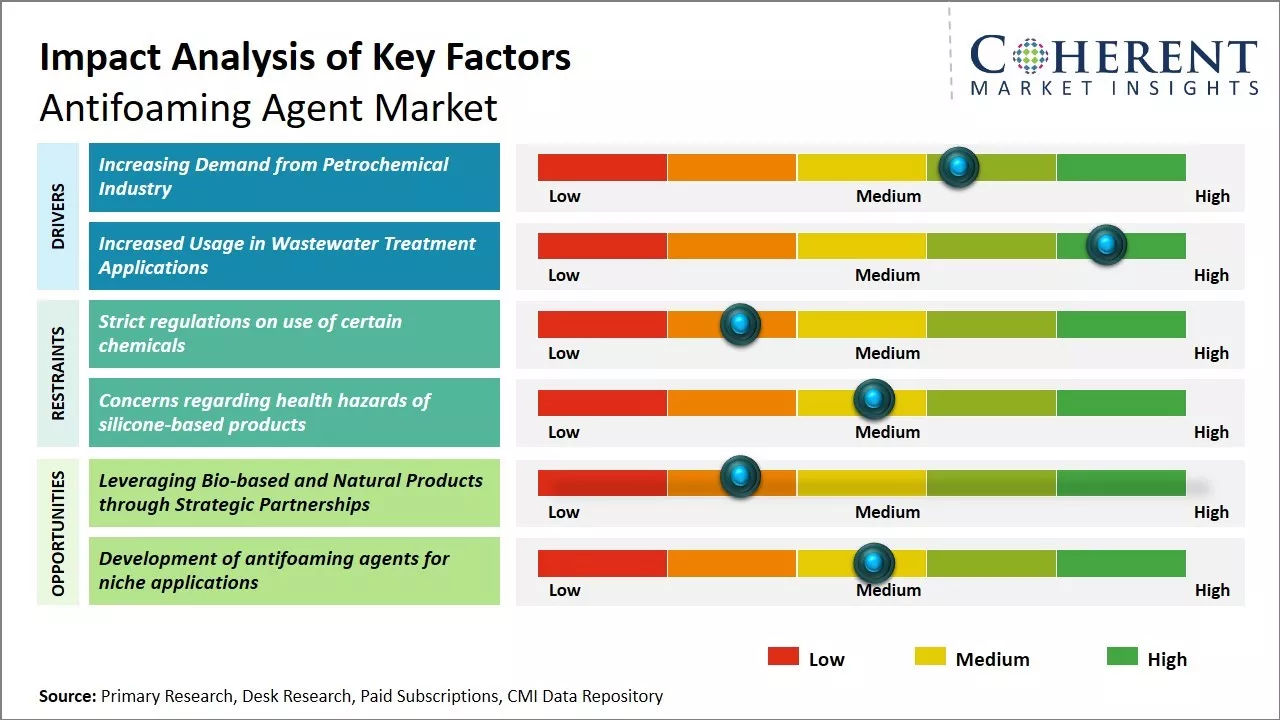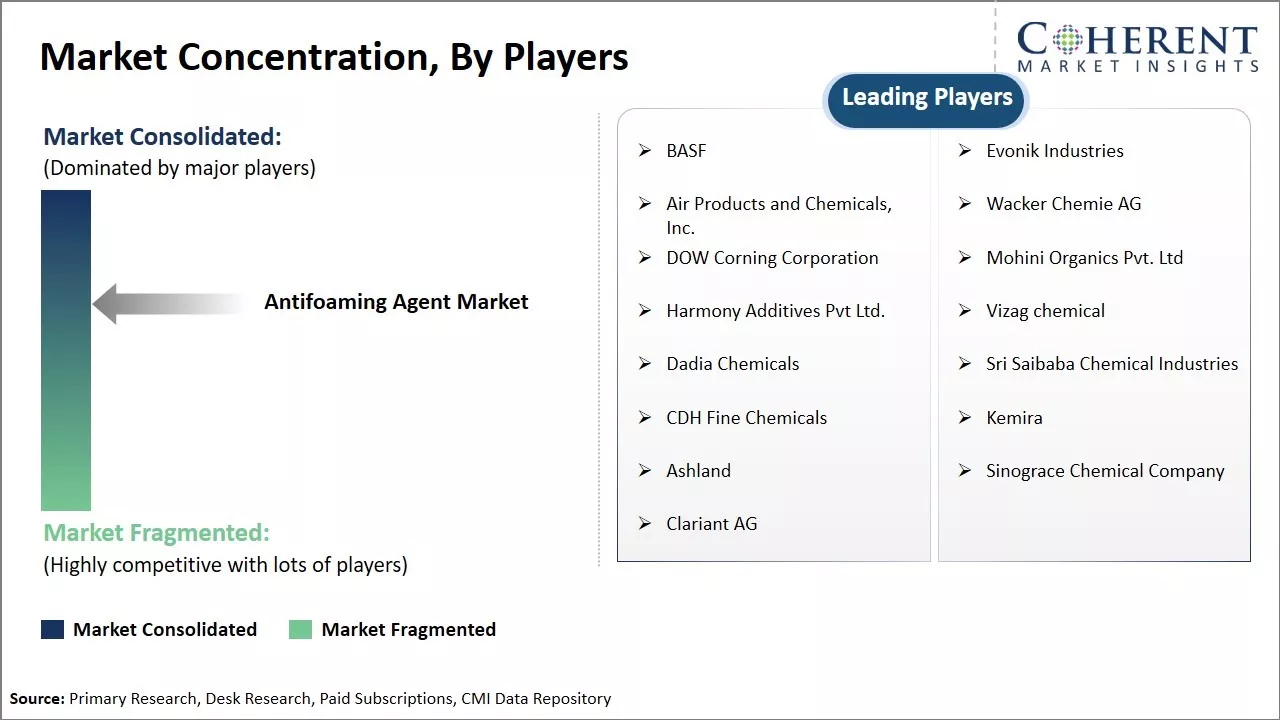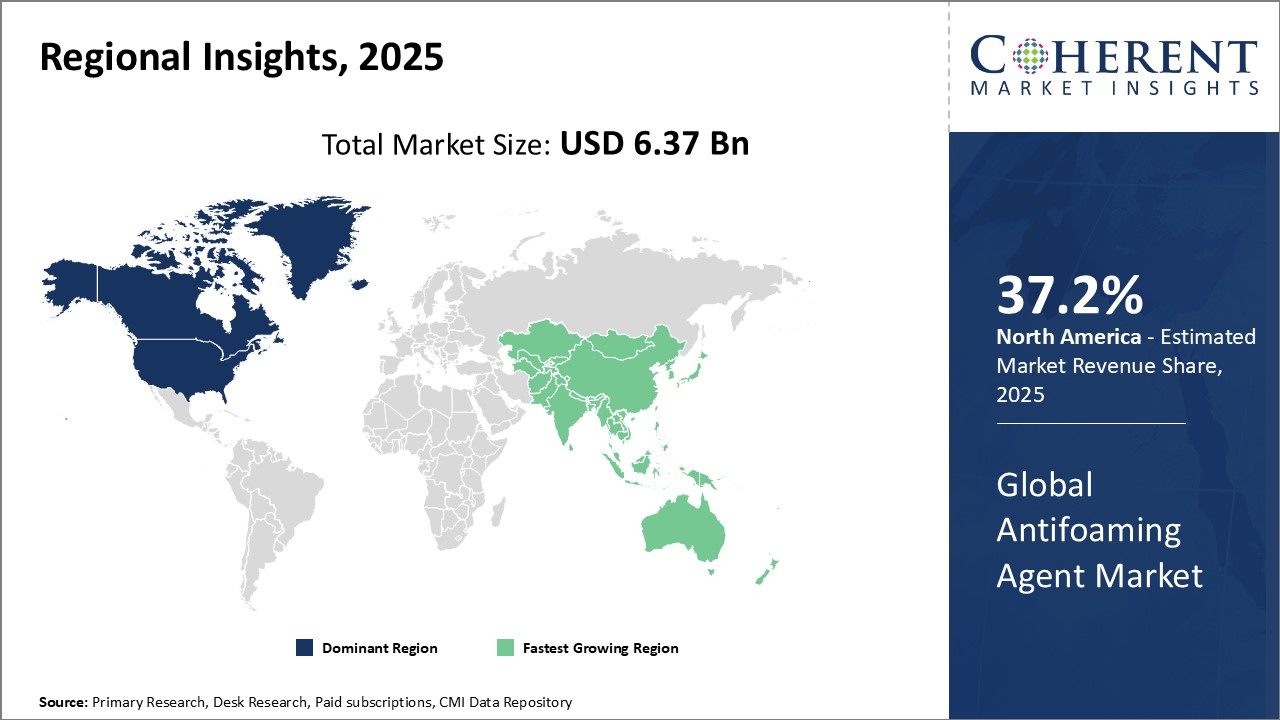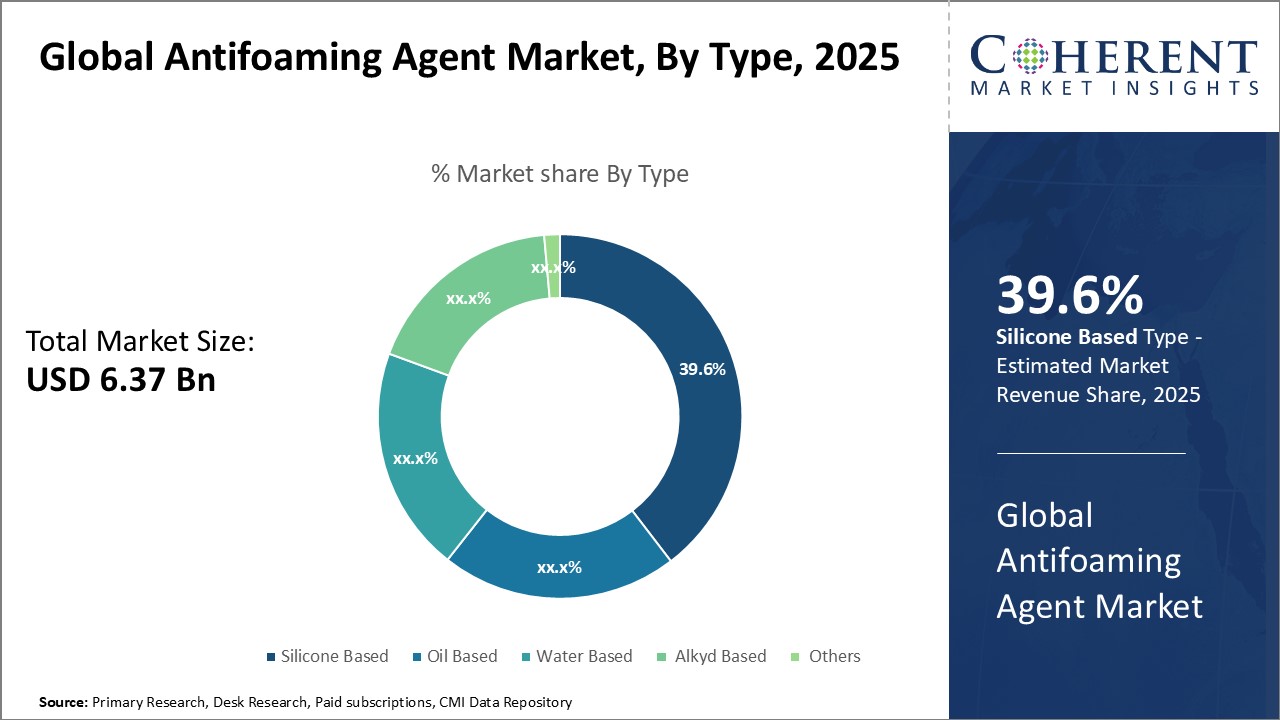Global Antifoaming Agent Market Size and Forecast 2025 - 2032
The Antifoaming Agent Market size is estimated at USD 6.37 Bn in 2025 and is expected to reach USD 8.79 Bn by 2032, exhibiting a compound annual growth rate (CAGR) of 4.7% from 2025 to 2032.
Key Takeaways of the Global Antifoaming Agent Market
- In terms of Type, Silicone Based segment is estimated to contribute 39. 6% share of the market in 2025.
- In terms of Application, Food Processing segment is expected to contribute 36. 1% share of the market in 2025.
- In terms of End User, Pharmaceuticals segment is anticipated to contribute around 37. 3% market share in 2025.
- North America is projected to be the leading region in the global antifoaming agent market with an expected share of 37. 2% in 2025.
Market Overview
The market is witnessing increased demand from developing economies where industrial growth is robust. A wide range of applications across various end-use industries, such as petrochemicals, pharmaceuticals, pulp and paper, and others, are expected to drive the demand for antifoaming agents over the forecast period.
Environmental regulations regarding the use of harsh chemicals with aquatic toxicity are prompting manufacturers to invest in eco-friendly antifoaming agent formulations. Regulations coupled with sustainability priorities of end users are defining the current market trend that seeks environmentally acceptable products.

To learn more about this report, Download Free Sample
Market Concentration and Competitive Landscape

To learn more about this report, Download Free Sample
Current Events and Its Impact
|
Current Events |
Description and its impact |
|
Geopolitical Disruptions in Global Trade Dynamics
|
|
|
Regulatory Pressures on Chemical Formulations
|
|
Uncover macros and micros vetted on 75+ parameters: Get instant access to report
Impact of AI on the Global Antifoaming Agent Market
Artificial intelligence (AI) is revolutionizing the antifoaming agent market by enhancing production efficiency, enabling precise foam control, and driving sustainable innovation.
- Dow Chemical is leveraging AI-driven predictive modeling to optimize silicone antifoam formulations in real time, cutting batch variation by 35% and reducing R&D time from 18 to 6 months.
- BASF uses AI-driven dosing control in paper mills, where sensors and neural networks adjust antifoam injection every 30 seconds. This has reduced antifoam use by 22%, maintained optimal performance, and eliminated manual disruptions.
- Evonik Industries uses computer vision AI systems to analyze foam behavior, using deep learning models trained on over 50,000 images to predict antifoam performance in minutes—cutting quality control costs by 40% and speeding up customer approvals.
Consumer Behavior Analysis
- In the food and beverage industry, companies like Nestlé and PepsiCo utilize food-grade antifoams during production processes such as mixing, fermentation, and bottling to prevent foam-related issues.
- Companies like Coca-Cola, often prioritizes food-grade antifoams, emphasizing their safety for consumption and compliance with stringent regulations like FDA approval, making silicone-based options a common and suitable choice due to these requirements.
- Companies such as Danone, BP, and Merck consider several key factors when selecting antifoams, including the product's effectiveness and regulatory compliance, its ease of integration into existing operations, environmental impact, cost-effectiveness, and the assurance of long-term availability.
Market Trends
Increasing Demand from Petrochemical Industry
The petrochemical industry has seen tremendous growth over the past few decades owing to rising demand for plastics, chemicals, and other petroleum products from various end-use industries such as construction, automotive, and packaging.
According to data published by Ministry of Petroleum in January 2025, India's chemical and petrochemical industry is expected to reach USD 300 billion by 2025.
Increased Usage in Wastewater Treatment Applications
Mounting global concern about water pollution and scarcity has amplified focus on wastewater treatment. Advanced treatment methodologies involving processes like coagulation, flocculation, and sedimentation are increasingly being adopted worldwide to remove contaminants from industrial and municipal wastewater before recycling/reuse or safe disposal.
For instance, the Changi NEWater Factory in Singapore is a benchmark facility in water reclamation, operating under the national NEWater program. This plant treats 228,000 cubic meters of municipal wastewater per day, employing a multi-stage advanced treatment process to produce ultra-clean reclaimed water.
Moreover, tightening environmental regulations across many countries mandate advanced wastewater treatment before disposal. These factors have significantly propelled the application of antifoaming chemicals in water treatment plants as well as various industrial wastewater handling.
Market Opportunity: Leveraging Bio-based and Natural Products through Strategic Partnerships
Introducing bio-based and natural products answers the call for sustainability. By collaborating, companies can pool resources and expertise, access new distribution channels, and effectively reach environmentally conscious consumers and industries seeking sustainable alternatives. These alliances facilitate the development of innovative, high-performance bio-based solutions, optimize natural ingredient supply chains, and build stronger brand recognition in the burgeoning green marketplace, ultimately unlocking new revenue streams and establishing a competitive edge in the evolving landscape of consumer preferences and regulatory focus on sustainability.
Global Antifoaming Agent Market Insights, by Type
In terms of Type, Silicone Based segment is expected to contribute 39.6% of the market share in 2025 owing to high efficiency of silicone in various applications compared to other types.
Silicone-based agents offer stronger and longer-lasting foam control relative to other options, owing to silicone's unique properties. Being hydrophobic and lipophobic, silicones are able to spread easily at interfaces and form an effective barrier against foam and bubble formation. This durability means silicone formulations provide persistent anti-foaming without degradation over time under different conditions.
Global Antifoaming Agent Market Insights, by Application
In terms of Application, Food Processing segment is expected to contribute 36.1% share of the market in 2025 owing to stringent quality and safety norms.
Foam control is critical in food manufacturing to ensure optimal processing and packaging while preserving product purity. By contrast, silicone-based antifoams can be nearly 100% recoverable from food products after use due to their hydrophobicity. Advanced silicone emulsions have also been developed for easy washing away without leaving undesirable deposits.
Global Antifoaming Agent Market Insights by End User
In terms of End User, Pharmaceuticals segment is expected to account for 40.3% share of the market owing to its stringent quality norms.
Eliminating foam is crucial in pharmaceutical manufacturing to ensure accurate dosing and mixing of active ingredients as well as avoiding product contamination. Water based agents require more wash steps and risk water introduction that hinders drying efficiency. Oil based versions also face challenges in guaranteeing complete removal from products. These advantages of silicone antifoams support compliance with rigorous cGMP and ICH guidelines for pharmaceutical processing. Their processing benefits have made them the standard for most sterile drug and medical applications.
Regional Insights

To learn more about this report, Download Free Sample
North America Antifoaming Agent Market Trends
North America has historically dominated the global antifoaming agent market with an estimated 37.2% market share in 2025 owing to the strong presence of end-use industries such as oil & gas, paints & coatings, pharmaceuticals, and detergents in the region. Countries such as the U.S. and Canada have advanced industrial infrastructure with wide distribution networks to support the supply of antifoaming agents.
Moreover, regulatory guidelines such as the Occupational Safety and Health Administration (OSHA) in the U.S. necessitate the use of defoamers to ensure worker safety in industries such as oil & gas.
Asia Pacific Antifoaming Agent Industry Trends and Growth Forecast
Asia Pacific region has been witnessing the fastest growth in the antifoaming agent market over the past few years. China, in particular, has emerged as a major importer of antifoaming agents to meet the demand from its powering chemicals sector. Meanwhile, India is also seeing an expansion of end-use industries like pharmaceuticals and food & beverages, which presents significant opportunities for manufacturers and suppliers of antifoaming agents to increase exports to India.
U.S. Antifoaming Agent Market Analysis
The U.S. antifoaming agent industry is experiencing steady growth, driven by robust demand from key sectors such as food and beverage processing, pharmaceuticals, water treatment, pulp and paper, and oil and gas.
Dow Corning Corporation, a U.S.-based company, remains a market leader with a strong portfolio of silicone-based antifoaming agents, widely used across industrial and pharmaceutical applications due to their thermal stability and long-lasting performance. However, Dow and other chemical giants are facing growing competition from specialty chemical companies such as Evonik Industries, BASF Corporation, etc.
Pharma, F&B, and Water Treatment Fuel India’s Antifoaming Agent Market
India antifoaming agent market is experiencing robust growth, fueled by the expansion of its pharmaceutical, food and beverage, and wastewater treatment sectors. This growth is accompanied by an increasing demand for environment-friendly and sustainable antifoaming solutions.
Technological advancements are leading to the development of more efficient and specialized antifoaming agents tailored for diverse industrial applications. Both domestic companies and multinational corporations actively participate in this dynamic market. For instance, Wacker Metroark, a joint venture between Wacker Chemie AG and Metroark, has been expanding its silicone production capabilities in India. The expansion underscores Wacker's commitment to meeting the increasing demand for silicones in India and Southeast Asia.
Market Report Scope
Global Antifoaming Agent Market Report Coverage
| Report Coverage | Details | ||
|---|---|---|---|
| Base Year: | 2024 | Market Size in 2025: | USD 6.37 Bn |
| Historical Data for: | 2020 To 2024 | Forecast Period: | 2025 To 2032 |
| Forecast Period 2025 to 2032 CAGR: | 4.7% | 2032 Value Projection: | USD 8.79 Bn |
| Geographies covered: |
|
||
| Segments covered: |
|
||
| Companies covered: |
BASF, Evonik Industries, Air Products and Chemicals, Inc., Wacker Chemie AG, DOW Corning Corporation, Mohini Organics Pvt. Ltd, Harmony Additives Pvt Ltd., Vizag chemical, Dadia Chemicals, Sri Saibaba Chemical Industries, CDH Fine Chemicals, Kemira, Ashland, Sinograce Chemical Company, Clariant AG |
||
| Growth Drivers: |
|
||
| Restraints & Challenges: |
|
||
Uncover macros and micros vetted on 75+ parameters: Get instant access to report
Global Antifoaming Agent Industry News
- In October 2024, Evonik launched two sustainable defoamers, TEGO Foamex 16 and TEGO Foamex 11 at the American Coatings Show 2024 held at the Indiana Convention Center in Indianapolis.
- In September 2024, JebChem introduced a fluoro-modified silicone antifoaming agent improving air release in coatings.
- In February 2024, DIC Corporation developed a PFAS-free antifoaming agent for electric vehicle lubricating oils.
Analyst View
- The antifoaming agent market is experiencing a fundamental shift toward sustainability that's creating both opportunities and existential threats for traditional players. Silicone-based antifoams, while technically superior, are facing mounting regulatory pressure and customer resistance due to bioaccumulation concerns, forcing manufacturers to pivot toward bio-based alternatives. Silicone regulations are challenging Europe, while Asia Pacific is set for rapid growth, led by China and India. China is a significant producer and consumer.
- Battery manufacturing for electric vehicles is driving significant demand for specialized antifoams capable of withstanding the unique chemistry of lithium-ion Companies that develop effective, non-contaminating solutions for this application are poised to lead the market in the coming decade.
Market Segmentation
- Type Insights (Revenue, USD Bn, 2020 - 2032)
- Water Based
- Oil Based
- Silicone Based
- Alkyd Based
- Others (Polymer Based, etc.)
- Application Insights (Revenue, USD Bn, 2020 - 2032)
- Adhesives
- Coatings
- Detergents
- Wood Pulp
- Food Processing
- Others (Wastewater Treatment, etc.)
- End User Insights (Revenue, USD Bn, 2020 - 2032)
- Oil and gas
- Paint and coatings
- Food and Beverages
- Pharmaceuticals
- Textile
- Others (Pulp and Paper, etc.)
- Regional Insights (Revenue, USD Bn, 2020 - 2032)
- North America
- U.S.
- Canada
- Latin America
- Brazil
- Argentina
- Mexico
- Rest of Latin America
- Europe
- Germany
- U.K.
- Spain
- France
- Italy
- Russia
- Rest of Europe
- Asia Pacific
- China
- India
- Japan
- Australia
- South Korea
- ASEAN
- Rest of Asia Pacific
- Middle East & Africa
- GCC Countries
- Israel
- Rest of Middle East & Africa
- Key Players Insights
- BASF
- Evonik Industries
- Air Products and Chemicals, Inc.
- Wacker Chemie AG
- DOW Corning Corporation
- Mohini Organics Pvt. Ltd
- Harmony Additives Pvt Ltd.
- Vizag chemical
- Dadia Chemicals
- Sri Saibaba Chemical Industries
- CDH Fine Chemicals
- Kemira
- Ashland
- Sinograce Chemical Company
- Clariant AG
Sources
Stakeholder:
Manufacturers & Suppliers of Antifoaming Agents,
Distributors/Dealers/Wholesalers,
End-use Industry Experts & Professionals,
Market Consultants and Analysts,
Others
Databases:
Euromonitor International,
Others
Magazines:
Chemical Engineering Magazine,
Specialty Chemicals Magazine,
ICIS Chemical Business,
Others
Journals:
Journal of Surfactants and Detergents,
Journal of Industrial and Engineering Chemistry,
International Journal of Chemical Engineering,
Others
Newspapers:
The Economic Times,
Chemicals Industry Digest,
Business Standard,
Financial Times,
Others
Associations:
American Chemical Society (ACS),
European Chemical Industry Council (CEFIC),
Specialty Chemicals Association,
Society of Chemical Industry (SCI),
Others
Public Domain sources:
U.S. Environmental Protection Agency (EPA),
U.S. Food and Drug Administration (USFDA),
European Chemicals Agency (ECHA),
Organisation for Economic Co-operation and Development (OECD),
Others
Proprietary Elements:
CMI Data Analytics Tool,
Proprietary CMI Existing Repository of Information for Last 8 Years
*Definition: The antifoaming agent market consists of substances added to liquids to reduce and inhibit the formation of foam during production or transportation. Antifoaming agents work by lowering the surface tension of liquids so bubbles cannot form or their coalescence is accelerated. Common applications include preventing foaming in paints, coatings, pharmaceuticals, concrete mixtures, paper pulp, fermentation processes, and water treatment. Major antifoaming agent types used are oils, polymers, and silicone-based formulations.
Share
Share
About Author
Vidyesh Swar is a seasoned Consultant with a diverse background in market research and business consulting. With over 6 years of experience, Vidyesh has established a strong reputation for his proficiency in market estimations, supplier landscape analysis, and market share assessments for tailored research solution. Using his deep industry knowledge and analytical skills, he provides valuable insights and strategic recommendations, enabling clients to make informed decisions and navigate complex business landscapes.
Missing comfort of reading report in your local language? Find your preferred language :
Transform your Strategy with Exclusive Trending Reports :
Frequently Asked Questions
EXISTING CLIENTELE
Joining thousands of companies around the world committed to making the Excellent Business Solutions.
View All Our Clients

